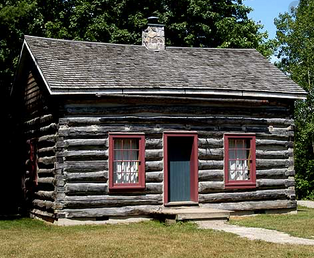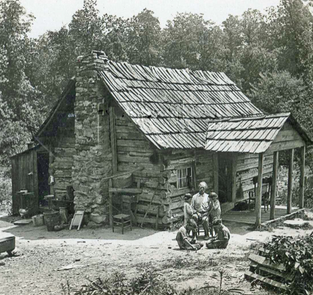The History of the Log cabin
- Larry Solomon
- Feb 1, 2021
- 3 min read
The Great Lodge exemplifies the log cabin’s long and impactful history. From humble one-room dwellings, the log cabin evolved into the modern log home—some small and pragmatic, others grand and luxurious. The Great Lodge, built at the dawn of the 21st century, demonstrates the log home at its full potential; palatial and elegant, yet comfortable and woodsy.
The earliest known written description of a log cabin is found in a treatise called De Architectura, written by Roman architect Vitruvius Pollio around 30 BC. However, the log cabin we are familiar with today originated in Scandinavia, Eastern Europe and Northern Russia during the Bronze Age in 3,500 BC. Log cabins were widespread across Europe for thousands of years before they arrived in North America.
Log cabins were brought to the Delaware River Region by Swedish and Finnish pioneers during the early 17th century, and quickly became a valuable asset to the settlers of North America. Scandinavians brought with them the tools and knowledge necessary to build log cabin dwellings for the pioneers living and arriving there. The Scandinavian architecture was soon borrowed by other pioneers, who were intrigued at the relative simplicity of the construction technique; only a saw and axe were needed (no nails), and a single person could build an entire cabin in two weeks, or several days with help. Well suited to the 17th century settlers, log cabins quickly spread across modern day New Jersey, Pennsylvania, Maryland and over to the Midwest.
The minimal tools, skills and time commitment necessary, coupled with the abundance of forests and timber in the New World, led to the log cabin’s success. Log cabins became the standard architecture for North America’s pioneers between the 17th and 19th centuries. Pennsylvania-style log cabins, which evolved from the original Scandinavian design, arrived in Southern Ontario during the American Revolution, when Loyalists to the British crown left for Canada.
Because pioneer life was rugged and demanding, log cabins became associated with modesty, simplicity and hardship. Pioneer log cabins began as small squares, usually with one room, one door, and no windows. Corn cobs, stones and clay were pushed through the gaps between the logs to keep out the cold. Because they could be built quickly, they often served as a temporary shelter until a larger, more comfortable home could be constructed.
Over the centuries new styles evolved, with the addition of extra rooms, hallways, hearths, chimneys, and even lofts and patios. Improved ventilation, insulation, more advanced notch joints and other innovation made log cabins more waterproof, warm and comfortable. Entirely new designs, such as the Saddlebag Style (incorporating an extra room and porch) and the Adirondack Cabin (which included a higher, peaked roof) began emerging during the 1800s. During the 1850s, fancy log cabins known as ‘camps’ became prevalent as mountain vacation homes for the wealthy. Grand log homes started to emerge around this time, such as The Chief Joseph Ranch, built in 1917 and featured in the TV series Yellowstone. These spacious buildings departed from their earlier utilitarian reputation, paving the way for the grand log homes seen today. During the 20th century log cabins continued to evolve away from their makeshift origins and towards permanent, fully functional residences. More construction styles, such as the chalet, began surfacing, and people started choosing to construct log homes for aesthetic reasons as well as practical.
Today, the evolution of the log cabin culminates with the log mansion. Rare and treasured, each log mansion is uniquely stunning.The Great Lodge, as one of Canada’s largest log buildings and perhaps Ontario’s largest log residence, bridges antiquity with luxury. Truly breathtaking, The Great Lodge’s soaring ceilings and magnificent logs combine the feats of modern architecture with history. The Great Lodge has impressed log home experts around the world; specialists from Scandinavia and elsewhere have visited to marvel at its construction.
Log cabins have captured our cultural imagination as a symbol of the pioneering spirit, the reward of hard work, and as an avenue for connecting with the natural world. The log cabin’s humble beginning as a practical means to house pioneers has evolved over five centuries into the sturdy and spectacular log homes we are familiar with today. The Great Lodge sits at the apex of those 3,500 years of history.







